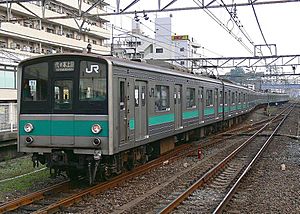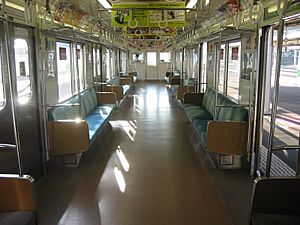207 series (JR East) facts for kids
Quick facts for kids 207 series |
|
|---|---|
 |
|

Interior
|
|
| In service | 1986-2009 |
| Constructed | 1986 |
| Specifications | |
| Track gauge | 1,067mm |
The 207 series (207系) (also known as the 207-900 series (207系900番台)) was a special type of train in Japan. It was an electric multiple unit (EMU), which means it's a train made of several cars that can move on their own using electricity. This train was first used in 1986 by Japanese National Railways (JNR). Later, it was operated by East Japan Railway Company (JR East).
This train ran on the Joban Line and also went directly onto the Tokyo Metro Chiyoda Line. Only one set of these trains was ever built, and it had 10 cars. The 207 series was retired in December 2009.
What is an EMU Train?
An electric multiple unit (EMU) is a type of train that uses electricity to move. Unlike trains pulled by a separate engine, an EMU has motors in many of its cars. This makes the train powerful and able to speed up and slow down quickly. EMUs are very common for commuter services, like the 207 series, because they are efficient for carrying many passengers.
History of the 207 Series
The 207 series was built in 1986. It was designed to run on two different train lines: the Joban Line and the Tokyo Metro Chiyoda Line. This kind of service, where a train goes from one line directly onto another, is called "through services." It helps passengers travel without changing trains.
Only one train set of the 207 series was ever made. It had 10 cars. This made it a very unique train in Japan's railway history. It served passengers for many years, from 1986 until it was taken out of service in December 2009.
Images for kids


